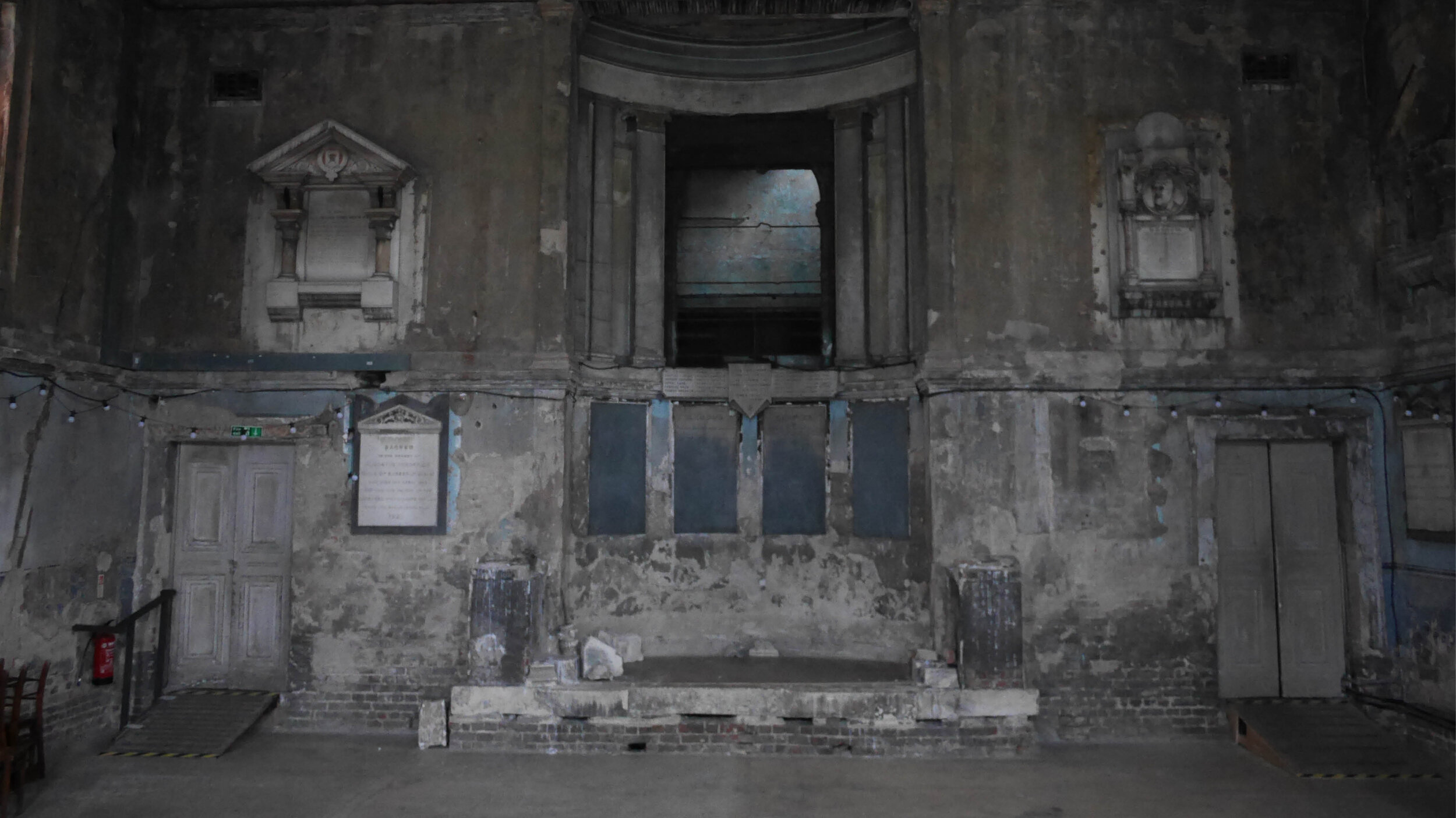
History and Conservation
Some buildings lose their charm over time but once a chapel, always a chapel. A pillar of hope and history, Asylum Chapel still stands strong despite seeing 200 years’ worth of South London’s past. Today, the building is a sanctum for creatives and couples in love alike, but what’s the chapel’s backstory?

Inception and early history
Established in or around 1827, Caroline Gardens Chapel in Peckham formed the heart of London’s largest complex of almshouses (charitable housing) originally known as the Licensed Victuallers’ Benevolent Institution Asylum (LVBI). The Grade II listed site was not a psychiatric facility – here, ‘asylum’ traditionally meant ‘sanctuary’ – and was actually a home for elderly, retired pub landlords.
Residents were entitled to a small weekly cash payment, coal, medical care and medicine. With the welfare state still being over 100 years from creation, almshouses were an important part of life, offering impoverished Georgian and Victorian elders the only alternative to destitution or the workhouse.
An impressive 10,000 people are reported to have watched the complex’s opening ceremony despite North Peckham being largely rural at that time – an area of market gardens and fields near Old Kent Road and Peckham New Town. The site was considered exceptionally large, with early architectural historian Nicolaus Pevsner labeling the six-acre complex as “the only grand composition among the many almshouses of Camberwell.”

The Chapel
The chapel soon became the beating heart of the community. A contemporary account stated that the services were “bright and partly choral”, noting that the congregation’s singing excellence was largely attributed to the established Licensed Victuallers’ Choral Association. Interestingly, the association was “composed chiefly of the younger members of the various families who attend[ed] the Asylum Chapel.”
The chapel thrived thanks to its congregation, contributions and benefactors. It had a handmade Messrs Bevington and Sons organ, described to have had “considerable power… erected by voluntary contributions”. The walls bore “several costly tablets to the memory of benefactors, the most conspicuous being them to HRH the Duke of Sussex and HRH the Prince Consort”. Most of these carved stone memorials are still there today.
In 1858 the Albert Wing was added, and opened by the Prince Consort himself, adding 31 more dwellings. As a result, a 16ft statue of Albert was unveiled in the middle of the lawn outside, unveiled in 1864 by the Prince of Wales after Albert’s death in 1861.



WWII
During the Second World War, the LVBI evacuated its tenants to Denham, in Buckinghamshire, for safety away from the city.
The Asylum was bombed and the chapel was almost completely gutted by an incendiary munition – with the astonishing exception of its iconic stained-glass windows and fascinating collection of carved stone funerary monuments.
After the war, the chapel was stabilised and made watertight by filling the crypt with concrete and adding a rudimentary asbestos-cement roof. WWII has become a pivotal part of the chapel’s history, amazing the masses with the fact that even a bomb could not weather the steadfast stained glass windows and the other emblems of history it possesses.
The LVBI’s board of management came to prefer the new site in Buckinghamshire and, in 1959, the last tenants moved to Denham, along with the statue of Prince Albert. The Asylum was sold to the London Borough of Southwark in 1960, which to this day uses its wings as social housing. Southwark renamed it ‘Caroline Gardens’ after Caroline Secker, a former resident and widow of James Secker, who was the marine in the Battle of Trafalgar said to have caught Nelson when he fell in 1805.
In 1960, the local paper described how the chapel was to become “a little theatre”, but this did not come to pass. Although the cottages are still in use, the chapel was never really used again until recently.

Conservation efforts
Around 1977, plans were put forward for the chapel’s restoration by the Jubilee Celebrations Committee. At that point, it was being used as a costume store by the London Borough of Southwark’s ‘Entertainments Department’. It was felt that just £20,000 would be enough to restore “the roof, internal walls, guttering, plasterwork, bricks and windows.” This endeavour came to nothing and, apart from evidence of a temporary wooden room having been built inside the chapel for use by artists in the 1990s, the building was left derelict.
In 2010, Jo Dennis and Dido Hallett started using the space for art projects, exhibitions, theatre productions and shoots, setting up the arts and conservation not for profit company and naming it 'Asylum'. Then, in 2013, Jo and Dido formed the team behind Maverick Projects to run ‘Asylum Chapel’ as it is now known: a flexible and creative project space with a wedding licence and a whole lot of heart behind it.
Between January – March 2018, in collaboration with Southwark Council, a programme of conservation works began on the portico and exterior of the chapel under the guidance of Historic England. Funding to support the works was awarded by both the Heritage Lottery Fund and Architectural Heritage Fund. These funds saw emergency reparation to the stonework on the roof and portico of the chapel. In August 2018 the chapel was granted further funds by both organisations as a Resilient Heritage project.
Asylum Chapel was also awarded a grant by the Heritage of London Trust to restore and conserve the George Drew memorial window. In 2020, the restored window was put back in pride of place on the North aspect of the chapel.
Booking one of our spaces couldn’t be easier.
Simply call us directly on 07539 595 158, or complete the form here. Whether it’s for commercial purposes, private events or your wedding, we’ll check availability for your dates and provide a quote as soon as possible.
All personal data herein are processed in accordance with UK data protection legislation. All feasible security measures are in place. Further information is in our Privacy Notice
Supporting ongoing conservation
By supporting the ongoing conservation of their flagship building, developing the chapel’s reach as a venue is Maverick Projects’ ultimate goal. In doing this they will get the building off the ‘at-risk’ register and bring unique experiences to the people of London and beyond, all of which would not be possible if Asylum Chapel was left unloved.
With the passion for and progress at Asylum Chapel, the team now also breathes life back into other forgotten spaces – AMP Studios, AMP Gallery and Safehouse 1 and 2 – curating them to deliver unique and diverse experiences in London.



